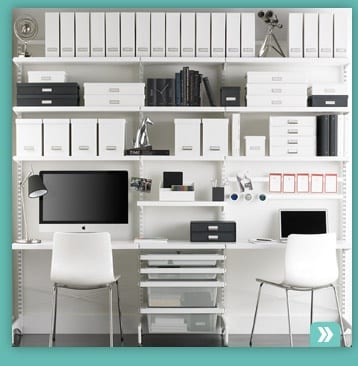As a small business owner, I love working in my home office. My commute time is short, my schedule is flexible, and I can work in my yoga pants and a t-shirt if I so choose. But creating a home office is more than just plopping a computer on a table and throwing in some file cabinets. If you want to run a successful business from this space it needs to be comfortable as well as functional. After all, you spend a lot of time in your home office and it’s worth it to invest time and money to make it a space you enjoy.
Comfortable Chair
– When you work from home, much of your time is spent sitting on your butt. Invest in a comfortable, ergonomic chair. You’ll be comfortable and your back will thank you in the long run.
Design Your Desk
– What do you plan to do at your desk? If your work is primarily done on a computer and entails very little paper, a small desk will do you well. However, if you like to spread out with paper reports and reference material close by, you might choose a larger desk or an L-shaped one.
Technology
– If your computer needs to reboot even once a day, you’re losing valuable productivity time. Ensure you have good working hardware and software and recognize when it’s time to upgrade. Less time dealing with IT issues means more time for you to work on the things that make you money.
Take Advantage of Vertical Space
– Shelves on the wall can hold envelopes, printer paper, resource materials, reference books and other supplies close by without taking up valuable desk space. To make open shelving more appealing, invest in attractive (yet functional) containers to hold the supplies you need.
Inbox
– Set-up an inbox for all incoming items like meeting notes, business cards, and items to read. Rather than dumping a pile on your desk, put it in your inbox. Calendar a weekly appointment to go through your inbox and process the items inside — add items to your to-do list or calendar, enter into your contacts, create a project file, put in a portable “to-read” folder, etc. Keep in mind your inbox is a holding spot that’s meant to be emptied. It’s not a file cabinet!
Active vs. Reference Files
– Keep your current project and active files close by in a desktop file holder or file drawer within easy reach. Reference files should be kept separately. They can be stored across the room or even in another area like a garage or closet since you will access them less often.
Schedule File Time
– No one likes to file paper, but it won’t magically file itself either. Create a file system that is easy to use and easy to access so that you can find what you need when you need it. Then schedule regular intervals to file the paperwork you need to keep.


